Detailed Analysis of Ethical and Socio-Legal Issues in a Case Scenario
VerifiedAdded on 2021/11/01
|6
|1371
|41
Essay
AI Summary
This essay delves into a case scenario, dissecting various ethical and socio-legal issues. The analysis addresses child abuse, discrimination against individuals with HIV/AIDS, and limitations on freedom of movement and worship, proposing solutions for each. The essay further explores ethical considerations in report writing, focusing on autonomy, privacy, and consent. Additionally, the essay presents arguments regarding juvenile detentions, domestic violence, and the Northern Territory intervention, offering perspectives on child protection, legal reform, and cultural sensitivity. The essay uses relevant references to support the arguments and analysis presented.
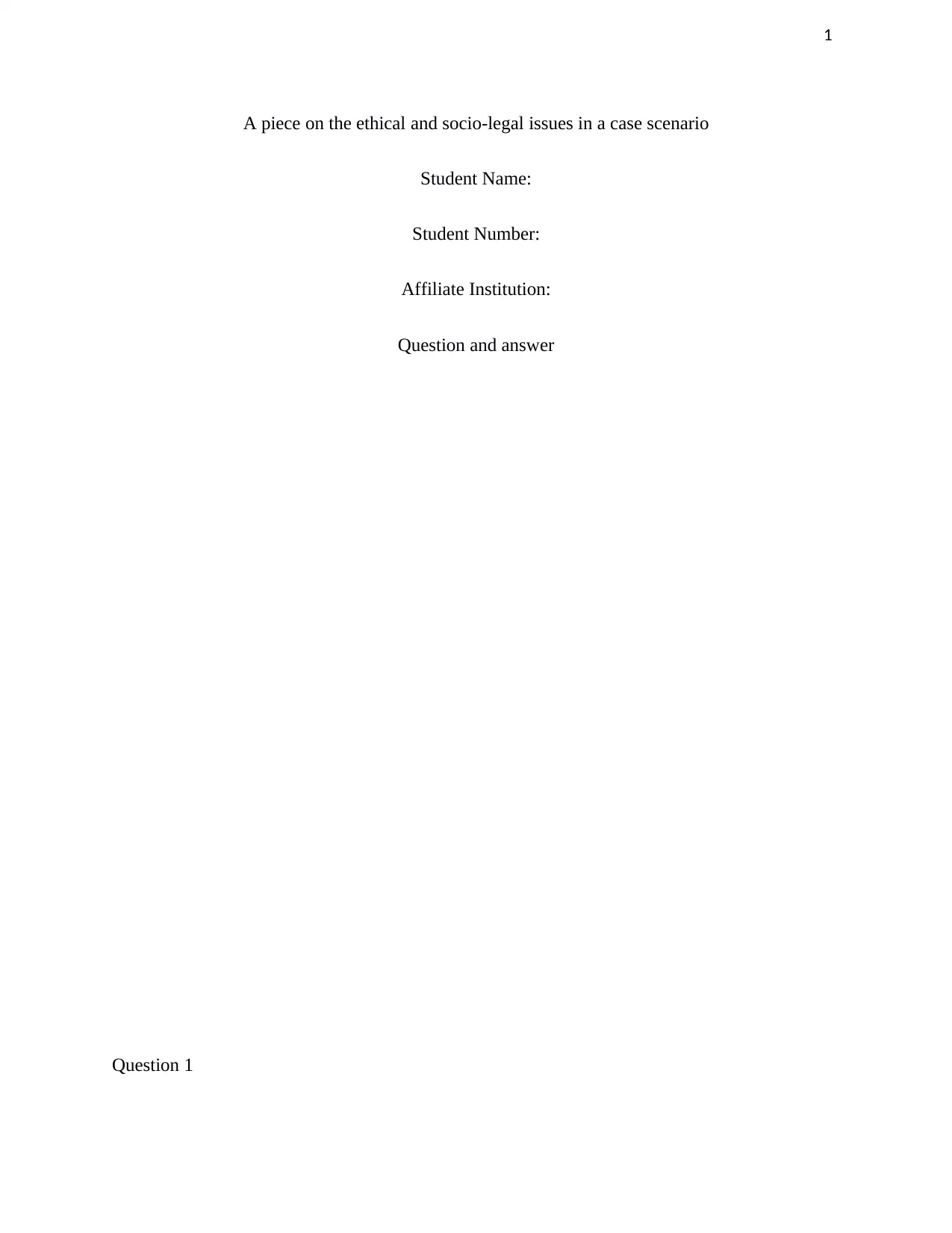
1
A piece on the ethical and socio-legal issues in a case scenario
Student Name:
Student Number:
Affiliate Institution:
Question and answer
Question 1
A piece on the ethical and socio-legal issues in a case scenario
Student Name:
Student Number:
Affiliate Institution:
Question and answer
Question 1
Paraphrase This Document
Need a fresh take? Get an instant paraphrase of this document with our AI Paraphraser
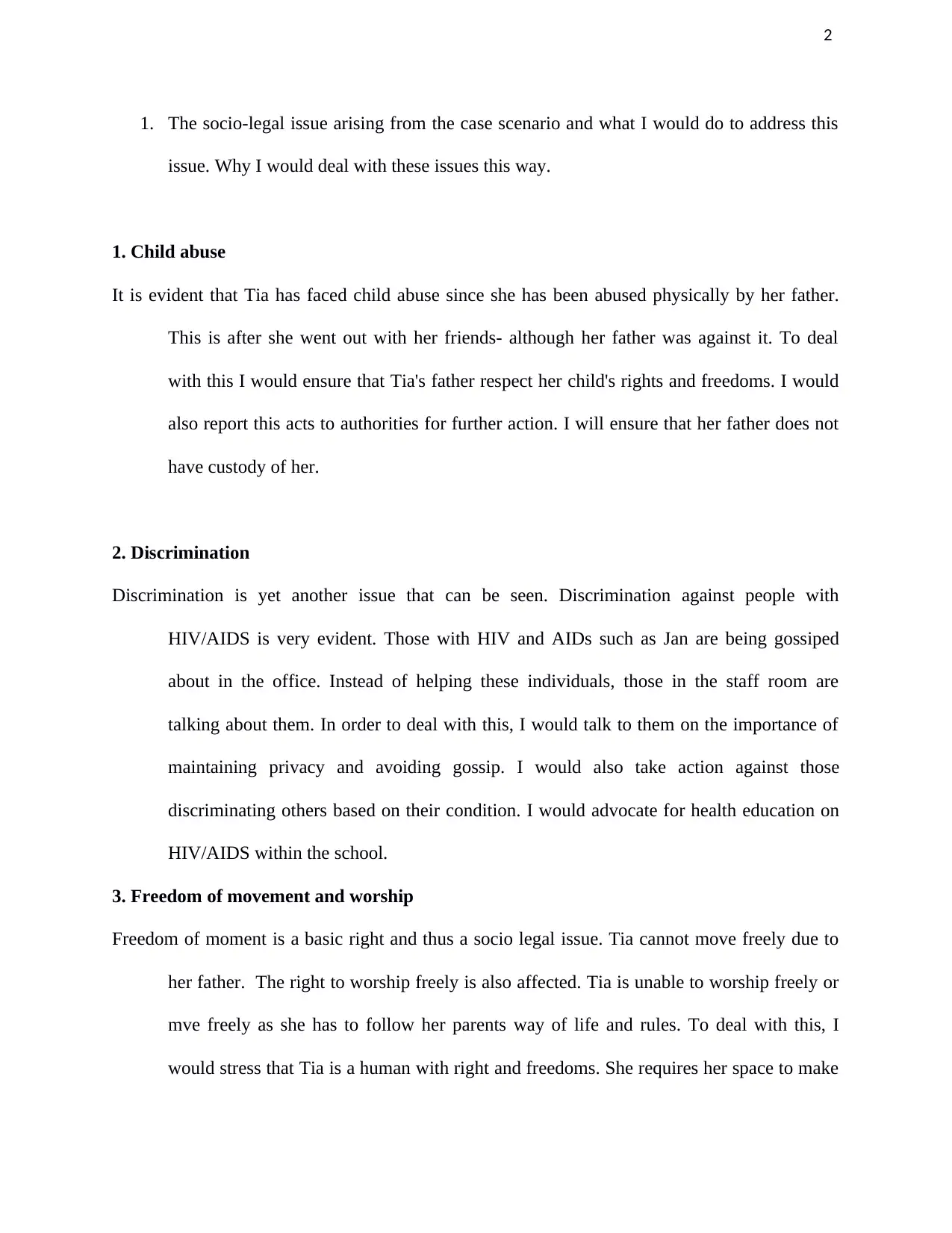
2
1. The socio-legal issue arising from the case scenario and what I would do to address this
issue. Why I would deal with these issues this way.
1. Child abuse
It is evident that Tia has faced child abuse since she has been abused physically by her father.
This is after she went out with her friends- although her father was against it. To deal
with this I would ensure that Tia's father respect her child's rights and freedoms. I would
also report this acts to authorities for further action. I will ensure that her father does not
have custody of her.
2. Discrimination
Discrimination is yet another issue that can be seen. Discrimination against people with
HIV/AIDS is very evident. Those with HIV and AIDs such as Jan are being gossiped
about in the office. Instead of helping these individuals, those in the staff room are
talking about them. In order to deal with this, I would talk to them on the importance of
maintaining privacy and avoiding gossip. I would also take action against those
discriminating others based on their condition. I would advocate for health education on
HIV/AIDS within the school.
3. Freedom of movement and worship
Freedom of moment is a basic right and thus a socio legal issue. Tia cannot move freely due to
her father. The right to worship freely is also affected. Tia is unable to worship freely or
mve freely as she has to follow her parents way of life and rules. To deal with this, I
would stress that Tia is a human with right and freedoms. She requires her space to make
1. The socio-legal issue arising from the case scenario and what I would do to address this
issue. Why I would deal with these issues this way.
1. Child abuse
It is evident that Tia has faced child abuse since she has been abused physically by her father.
This is after she went out with her friends- although her father was against it. To deal
with this I would ensure that Tia's father respect her child's rights and freedoms. I would
also report this acts to authorities for further action. I will ensure that her father does not
have custody of her.
2. Discrimination
Discrimination is yet another issue that can be seen. Discrimination against people with
HIV/AIDS is very evident. Those with HIV and AIDs such as Jan are being gossiped
about in the office. Instead of helping these individuals, those in the staff room are
talking about them. In order to deal with this, I would talk to them on the importance of
maintaining privacy and avoiding gossip. I would also take action against those
discriminating others based on their condition. I would advocate for health education on
HIV/AIDS within the school.
3. Freedom of movement and worship
Freedom of moment is a basic right and thus a socio legal issue. Tia cannot move freely due to
her father. The right to worship freely is also affected. Tia is unable to worship freely or
mve freely as she has to follow her parents way of life and rules. To deal with this, I
would stress that Tia is a human with right and freedoms. She requires her space to make
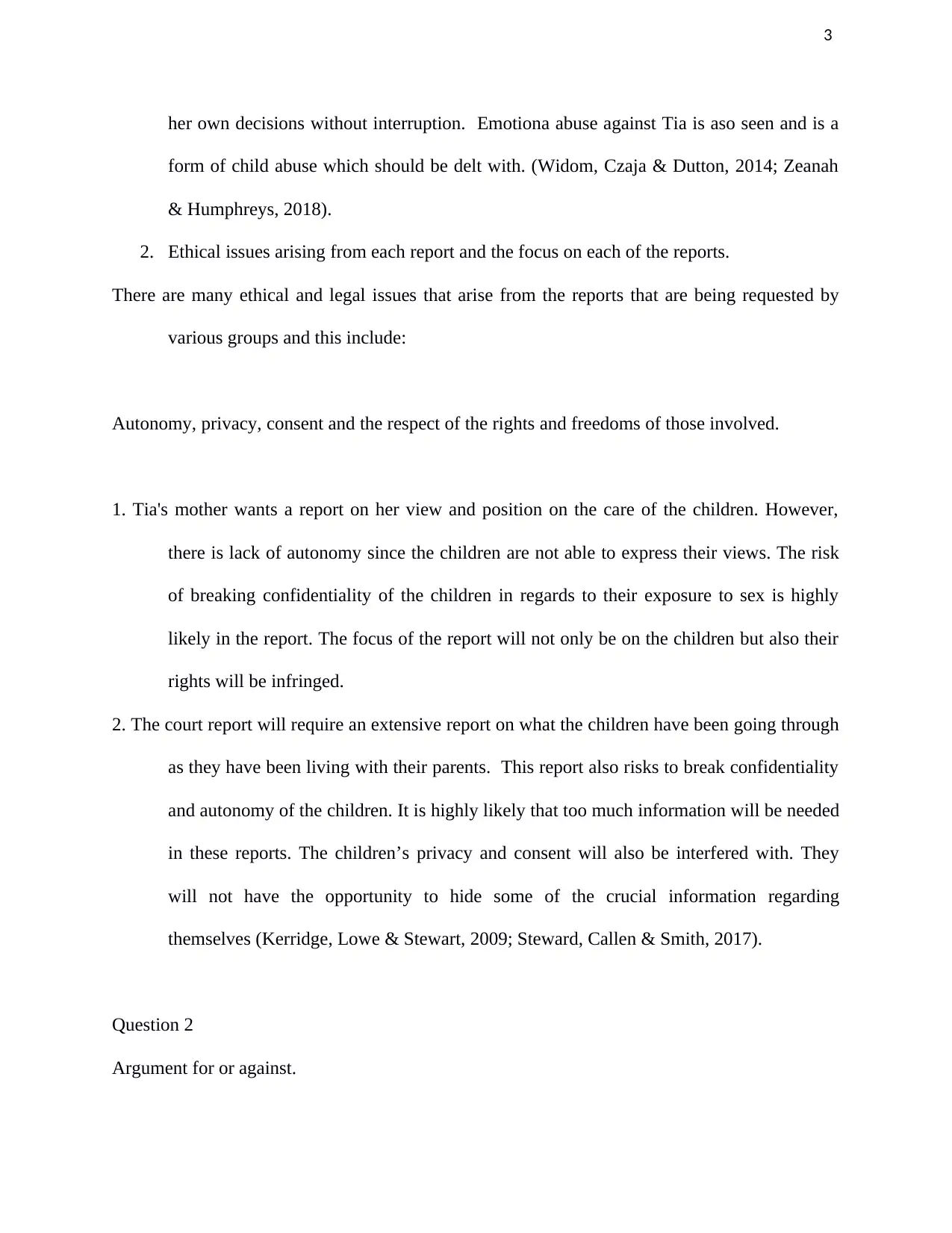
3
her own decisions without interruption. Emotiona abuse against Tia is aso seen and is a
form of child abuse which should be delt with. (Widom, Czaja & Dutton, 2014; Zeanah
& Humphreys, 2018).
2. Ethical issues arising from each report and the focus on each of the reports.
There are many ethical and legal issues that arise from the reports that are being requested by
various groups and this include:
Autonomy, privacy, consent and the respect of the rights and freedoms of those involved.
1. Tia's mother wants a report on her view and position on the care of the children. However,
there is lack of autonomy since the children are not able to express their views. The risk
of breaking confidentiality of the children in regards to their exposure to sex is highly
likely in the report. The focus of the report will not only be on the children but also their
rights will be infringed.
2. The court report will require an extensive report on what the children have been going through
as they have been living with their parents. This report also risks to break confidentiality
and autonomy of the children. It is highly likely that too much information will be needed
in these reports. The children’s privacy and consent will also be interfered with. They
will not have the opportunity to hide some of the crucial information regarding
themselves (Kerridge, Lowe & Stewart, 2009; Steward, Callen & Smith, 2017).
Question 2
Argument for or against.
her own decisions without interruption. Emotiona abuse against Tia is aso seen and is a
form of child abuse which should be delt with. (Widom, Czaja & Dutton, 2014; Zeanah
& Humphreys, 2018).
2. Ethical issues arising from each report and the focus on each of the reports.
There are many ethical and legal issues that arise from the reports that are being requested by
various groups and this include:
Autonomy, privacy, consent and the respect of the rights and freedoms of those involved.
1. Tia's mother wants a report on her view and position on the care of the children. However,
there is lack of autonomy since the children are not able to express their views. The risk
of breaking confidentiality of the children in regards to their exposure to sex is highly
likely in the report. The focus of the report will not only be on the children but also their
rights will be infringed.
2. The court report will require an extensive report on what the children have been going through
as they have been living with their parents. This report also risks to break confidentiality
and autonomy of the children. It is highly likely that too much information will be needed
in these reports. The children’s privacy and consent will also be interfered with. They
will not have the opportunity to hide some of the crucial information regarding
themselves (Kerridge, Lowe & Stewart, 2009; Steward, Callen & Smith, 2017).
Question 2
Argument for or against.
⊘ This is a preview!⊘
Do you want full access?
Subscribe today to unlock all pages.

Trusted by 1+ million students worldwide
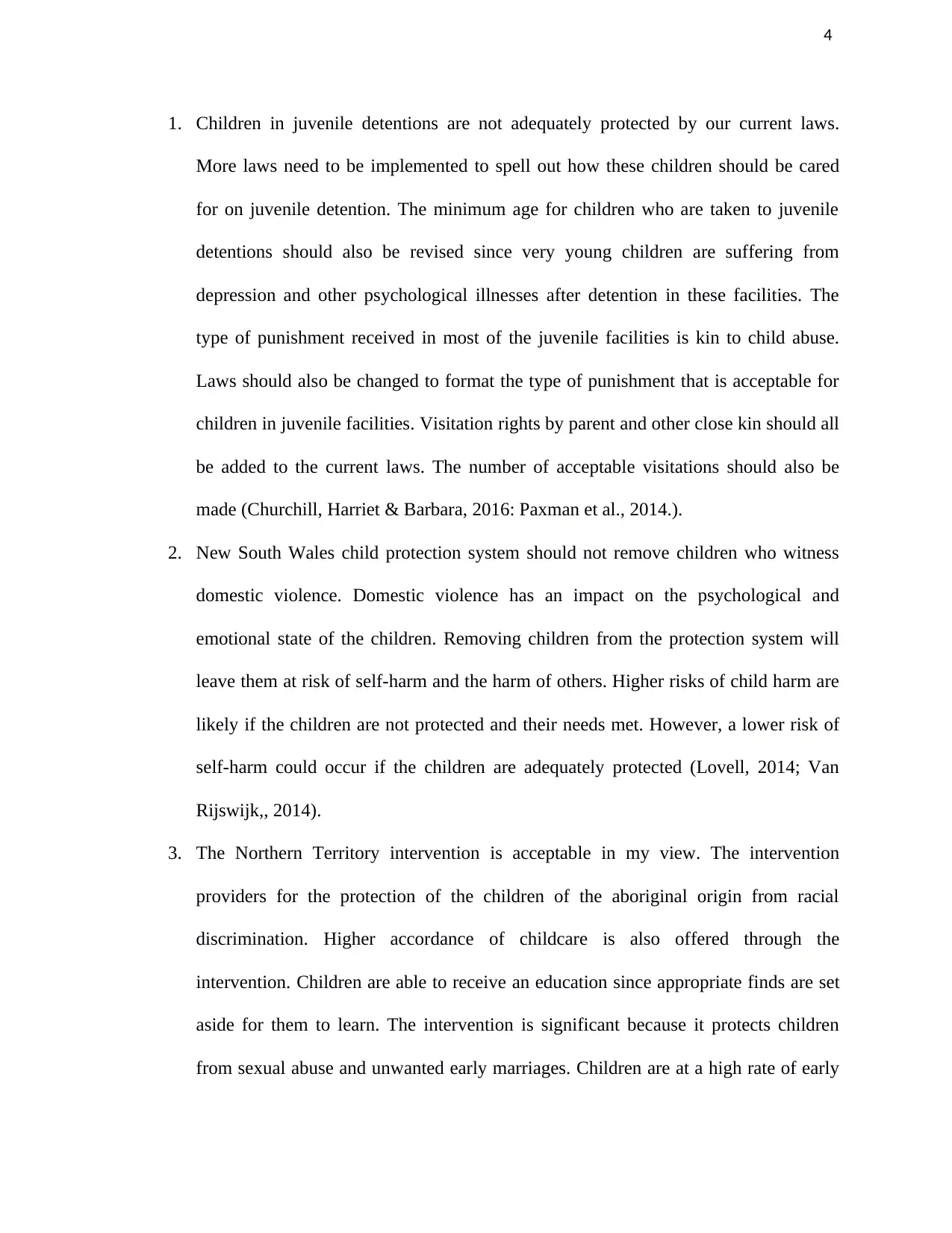
4
1. Children in juvenile detentions are not adequately protected by our current laws.
More laws need to be implemented to spell out how these children should be cared
for on juvenile detention. The minimum age for children who are taken to juvenile
detentions should also be revised since very young children are suffering from
depression and other psychological illnesses after detention in these facilities. The
type of punishment received in most of the juvenile facilities is kin to child abuse.
Laws should also be changed to format the type of punishment that is acceptable for
children in juvenile facilities. Visitation rights by parent and other close kin should all
be added to the current laws. The number of acceptable visitations should also be
made (Churchill, Harriet & Barbara, 2016: Paxman et al., 2014.).
2. New South Wales child protection system should not remove children who witness
domestic violence. Domestic violence has an impact on the psychological and
emotional state of the children. Removing children from the protection system will
leave them at risk of self-harm and the harm of others. Higher risks of child harm are
likely if the children are not protected and their needs met. However, a lower risk of
self-harm could occur if the children are adequately protected (Lovell, 2014; Van
Rijswijk,, 2014).
3. The Northern Territory intervention is acceptable in my view. The intervention
providers for the protection of the children of the aboriginal origin from racial
discrimination. Higher accordance of childcare is also offered through the
intervention. Children are able to receive an education since appropriate finds are set
aside for them to learn. The intervention is significant because it protects children
from sexual abuse and unwanted early marriages. Children are at a high rate of early
1. Children in juvenile detentions are not adequately protected by our current laws.
More laws need to be implemented to spell out how these children should be cared
for on juvenile detention. The minimum age for children who are taken to juvenile
detentions should also be revised since very young children are suffering from
depression and other psychological illnesses after detention in these facilities. The
type of punishment received in most of the juvenile facilities is kin to child abuse.
Laws should also be changed to format the type of punishment that is acceptable for
children in juvenile facilities. Visitation rights by parent and other close kin should all
be added to the current laws. The number of acceptable visitations should also be
made (Churchill, Harriet & Barbara, 2016: Paxman et al., 2014.).
2. New South Wales child protection system should not remove children who witness
domestic violence. Domestic violence has an impact on the psychological and
emotional state of the children. Removing children from the protection system will
leave them at risk of self-harm and the harm of others. Higher risks of child harm are
likely if the children are not protected and their needs met. However, a lower risk of
self-harm could occur if the children are adequately protected (Lovell, 2014; Van
Rijswijk,, 2014).
3. The Northern Territory intervention is acceptable in my view. The intervention
providers for the protection of the children of the aboriginal origin from racial
discrimination. Higher accordance of childcare is also offered through the
intervention. Children are able to receive an education since appropriate finds are set
aside for them to learn. The intervention is significant because it protects children
from sexual abuse and unwanted early marriages. Children are at a high rate of early
Paraphrase This Document
Need a fresh take? Get an instant paraphrase of this document with our AI Paraphraser
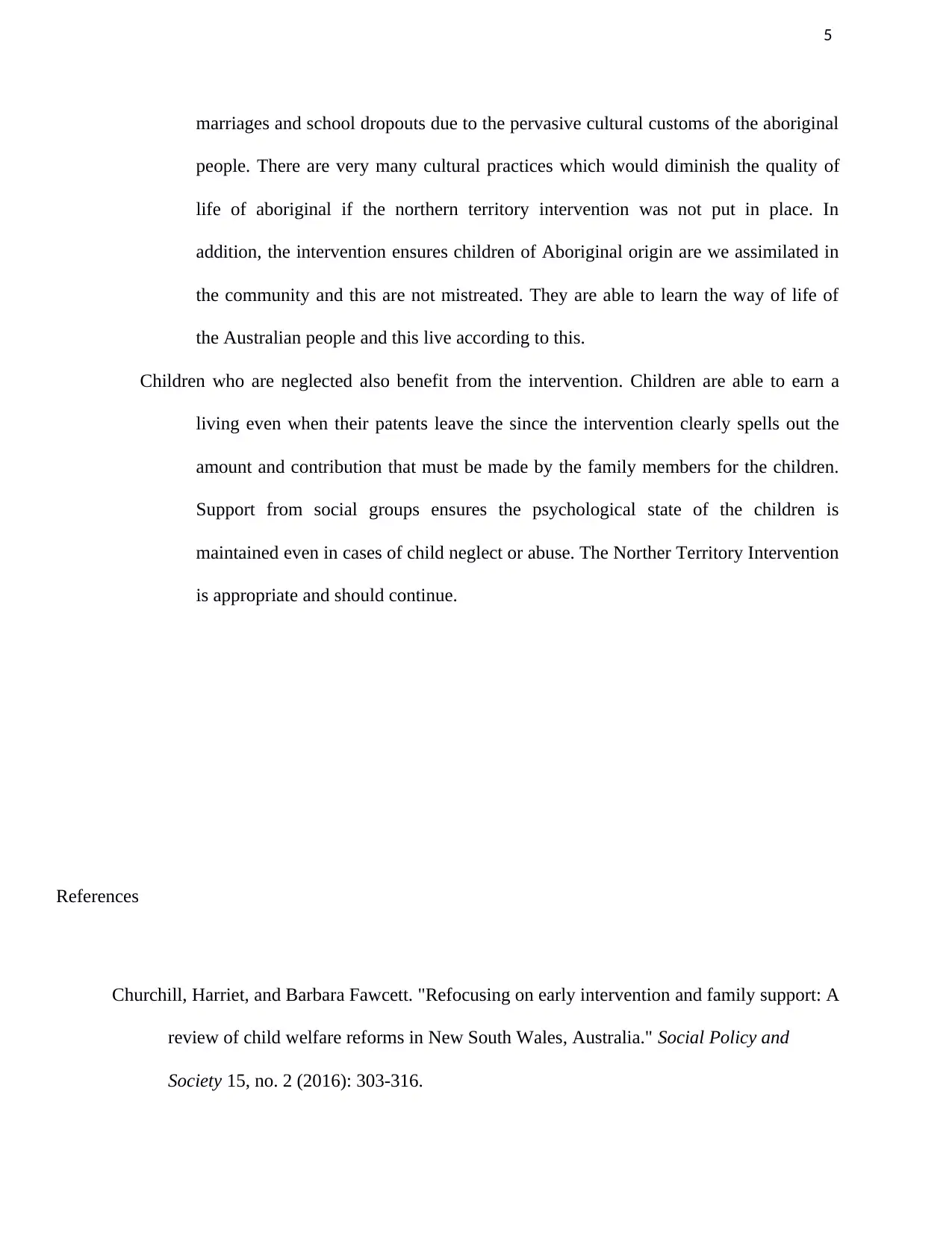
5
marriages and school dropouts due to the pervasive cultural customs of the aboriginal
people. There are very many cultural practices which would diminish the quality of
life of aboriginal if the northern territory intervention was not put in place. In
addition, the intervention ensures children of Aboriginal origin are we assimilated in
the community and this are not mistreated. They are able to learn the way of life of
the Australian people and this live according to this.
Children who are neglected also benefit from the intervention. Children are able to earn a
living even when their patents leave the since the intervention clearly spells out the
amount and contribution that must be made by the family members for the children.
Support from social groups ensures the psychological state of the children is
maintained even in cases of child neglect or abuse. The Norther Territory Intervention
is appropriate and should continue.
References
Churchill, Harriet, and Barbara Fawcett. "Refocusing on early intervention and family support: A
review of child welfare reforms in New South Wales, Australia." Social Policy and
Society 15, no. 2 (2016): 303-316.
marriages and school dropouts due to the pervasive cultural customs of the aboriginal
people. There are very many cultural practices which would diminish the quality of
life of aboriginal if the northern territory intervention was not put in place. In
addition, the intervention ensures children of Aboriginal origin are we assimilated in
the community and this are not mistreated. They are able to learn the way of life of
the Australian people and this live according to this.
Children who are neglected also benefit from the intervention. Children are able to earn a
living even when their patents leave the since the intervention clearly spells out the
amount and contribution that must be made by the family members for the children.
Support from social groups ensures the psychological state of the children is
maintained even in cases of child neglect or abuse. The Norther Territory Intervention
is appropriate and should continue.
References
Churchill, Harriet, and Barbara Fawcett. "Refocusing on early intervention and family support: A
review of child welfare reforms in New South Wales, Australia." Social Policy and
Society 15, no. 2 (2016): 303-316.
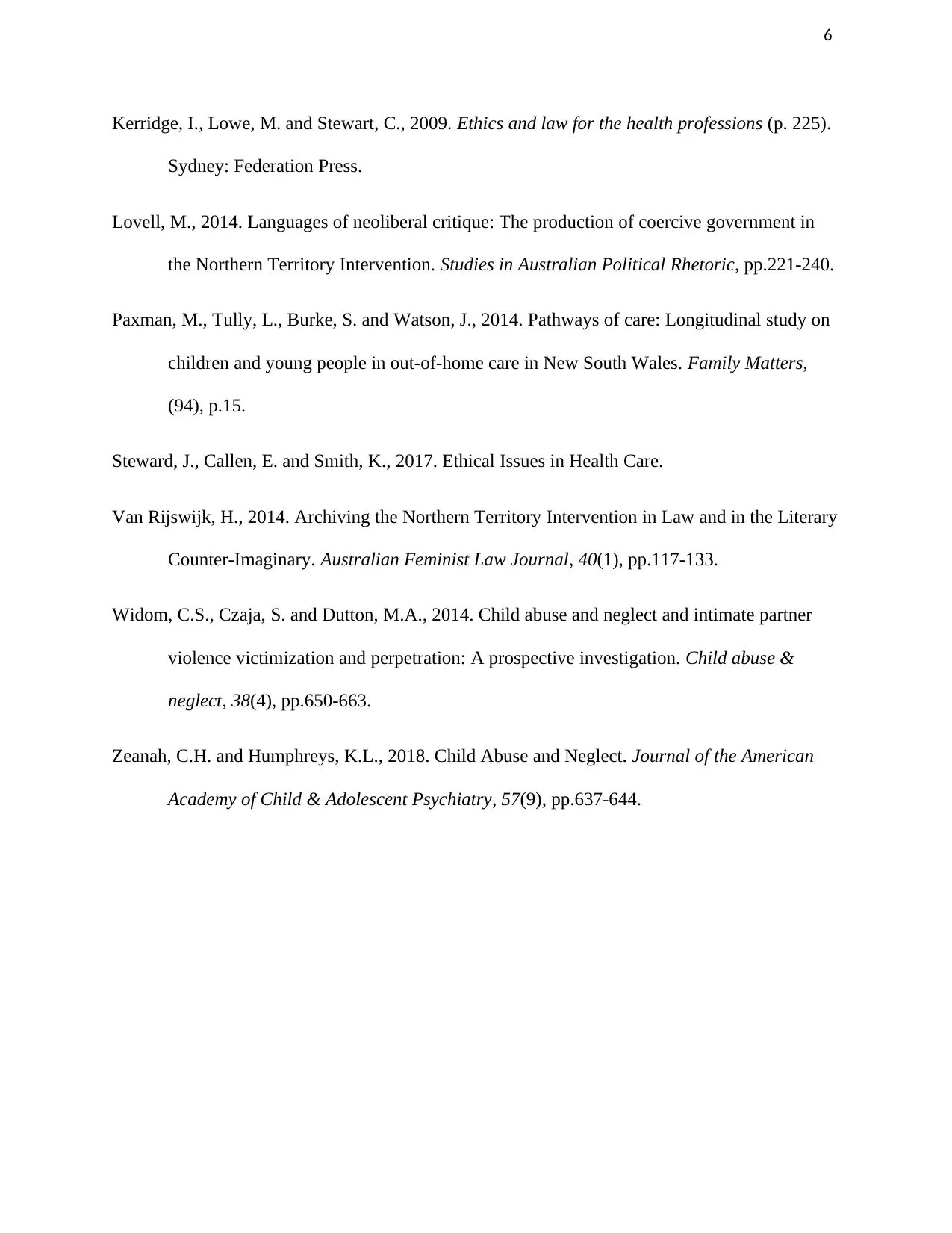
6
Kerridge, I., Lowe, M. and Stewart, C., 2009. Ethics and law for the health professions (p. 225).
Sydney: Federation Press.
Lovell, M., 2014. Languages of neoliberal critique: The production of coercive government in
the Northern Territory Intervention. Studies in Australian Political Rhetoric, pp.221-240.
Paxman, M., Tully, L., Burke, S. and Watson, J., 2014. Pathways of care: Longitudinal study on
children and young people in out-of-home care in New South Wales. Family Matters,
(94), p.15.
Steward, J., Callen, E. and Smith, K., 2017. Ethical Issues in Health Care.
Van Rijswijk, H., 2014. Archiving the Northern Territory Intervention in Law and in the Literary
Counter-Imaginary. Australian Feminist Law Journal, 40(1), pp.117-133.
Widom, C.S., Czaja, S. and Dutton, M.A., 2014. Child abuse and neglect and intimate partner
violence victimization and perpetration: A prospective investigation. Child abuse &
neglect, 38(4), pp.650-663.
Zeanah, C.H. and Humphreys, K.L., 2018. Child Abuse and Neglect. Journal of the American
Academy of Child & Adolescent Psychiatry, 57(9), pp.637-644.
Kerridge, I., Lowe, M. and Stewart, C., 2009. Ethics and law for the health professions (p. 225).
Sydney: Federation Press.
Lovell, M., 2014. Languages of neoliberal critique: The production of coercive government in
the Northern Territory Intervention. Studies in Australian Political Rhetoric, pp.221-240.
Paxman, M., Tully, L., Burke, S. and Watson, J., 2014. Pathways of care: Longitudinal study on
children and young people in out-of-home care in New South Wales. Family Matters,
(94), p.15.
Steward, J., Callen, E. and Smith, K., 2017. Ethical Issues in Health Care.
Van Rijswijk, H., 2014. Archiving the Northern Territory Intervention in Law and in the Literary
Counter-Imaginary. Australian Feminist Law Journal, 40(1), pp.117-133.
Widom, C.S., Czaja, S. and Dutton, M.A., 2014. Child abuse and neglect and intimate partner
violence victimization and perpetration: A prospective investigation. Child abuse &
neglect, 38(4), pp.650-663.
Zeanah, C.H. and Humphreys, K.L., 2018. Child Abuse and Neglect. Journal of the American
Academy of Child & Adolescent Psychiatry, 57(9), pp.637-644.
⊘ This is a preview!⊘
Do you want full access?
Subscribe today to unlock all pages.

Trusted by 1+ million students worldwide
1 out of 6
Your All-in-One AI-Powered Toolkit for Academic Success.
+13062052269
info@desklib.com
Available 24*7 on WhatsApp / Email
![[object Object]](/_next/static/media/star-bottom.7253800d.svg)
Unlock your academic potential
Copyright © 2020–2025 A2Z Services. All Rights Reserved. Developed and managed by ZUCOL.


